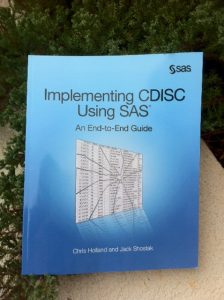 For decades, researchers and programmers have used SAS to analyze, summarize, and report clinical trial data. Now Chris Holland and Jack Shostak have written the first comprehensive book on applying clinical research data and metadata to the Clinical Data Interchange Standards Consortium (CDISC) standards.
For decades, researchers and programmers have used SAS to analyze, summarize, and report clinical trial data. Now Chris Holland and Jack Shostak have written the first comprehensive book on applying clinical research data and metadata to the Clinical Data Interchange Standards Consortium (CDISC) standards.
What does this mean for you—the programmers, analysts, and informaticists working with CDISC standards? I asked the authors specifically how their book will improve your work. Here's what they said. Implementing CDISC Using SAS: An End-to-End Guide will help you learn how to:
Implement the SDTM using BASE/SAS, the SAS Clinical Standards Toolkit, and SAS Clinical Data Integration
We give examples of how to construct your SDTM datasets on different budget and commitment levels. The first method employs BASE/SAS and Excel to generate the SDTM. Then we move on to taking metadata from Excel and into the SAS Clinical Standards Toolkit as a repository. We close by showing the graphical user interface based SAS Clinical Data Integration which is the SAS ETL tool of choice for building SDTM files.
Create a Define.XML file for SDTM and ADaM metadata
For those used to submitting traditional define.pdf files, define.xml can pose a bit of a challenge. We provide a BASE/SAS solution to this problem that the user can customize to their needs and also look at the ability of the SAS Clinical Standards Toolkit's ability to generate a define.xml file.
Analyze CDISC data using JMP Clinical
The advantage of CDISC data standards is that software tools can be developed to automate tasks based on those standard data structures. We show how JMP Clinical is just such a tool. It qualifies your data and then unleashes a standard battery of analyses on your data. And JMP Clinical can be used to perform Hy's Law liver toxicity analyses as well as automatic generation of patient profiles for clinical safety review.
Validate CDISC SDTM and ADaM data
You can use the SAS Clinical Standards toolkit as well as the OpenCDISC Validator to validate your CDISC data structures. When we say validate, we mean that these tools verify compliant data structures.
Prepare CDISC data for FDA submissions
Our book has a collection of advice and tools for how to submit data to the FDA. It goes beyond showing how to make SAS transport datasets. We provide tools for trimming long text fields which is a current concern for many as well as an automated supplemental qualifiers merge tool. We also provide general advice for how to prepare data for FDA submissions.
Get your copy of Implementing CDISC Using SAS: An End-to-End Guide today, or read a free chapter.
1 Comment
Thanks Chris and Jack for this great collection of CDISC examples in one book! The content and examples are all on target with current standards and FDA expectations.
Regards,
Sunil